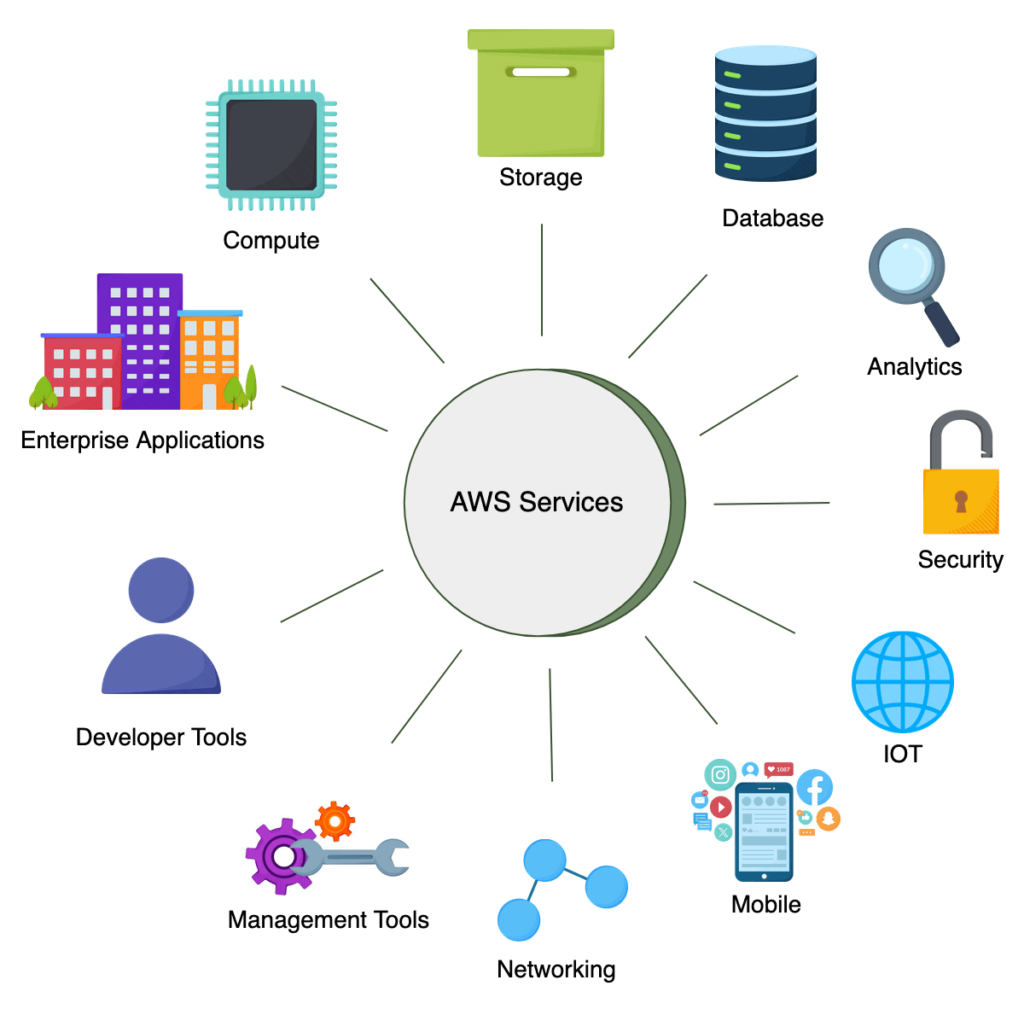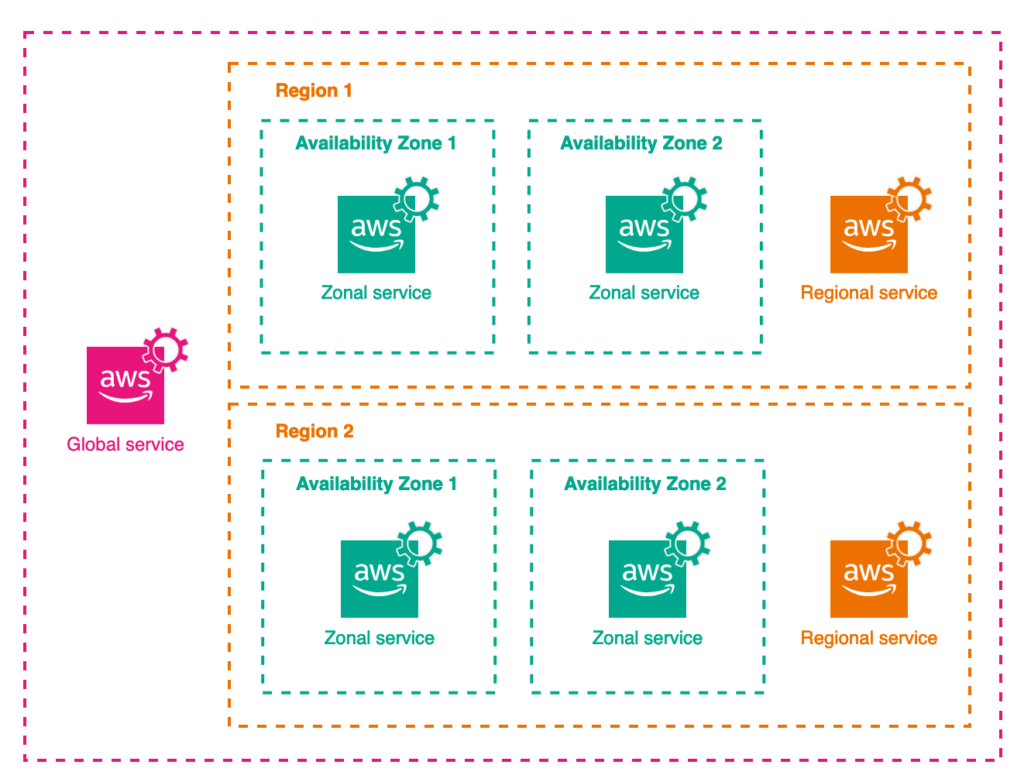Core Services
In this tutorial, we are going to explore the core services, such as compute, storage, database, network, machine learning, security, and management and governance offered by AWS.
The breadth of services offered by Amazon Web Services (AWS) is one of its defining characteristics, and AWS offers services across a wide range of categories, including compute, storage, networking, databases, machine learning, analytics, security, IoT, and many more.
Lets explore the AWS core services one by one.

1. Compute Services
AWS offers a range of compute services to deliver scalable and flexible processing power.
- Amazon EC2 (Elastic Compute Cloud): Provides scalable virtual servers, allowing users to quickly scale up or down based on demand. EC2 offers a variety of instance types optimized for different workloads.
- AWS Lambda: A serverless compute service that lets you run code in response to events without provisioning or managing servers. It’s great for microservices, data processing, and backend tasks.
- Amazon ECS (Elastic Container Service) & Amazon EKS (Elastic Kubernetes Service): Managed container services that support Docker and Kubernetes, making it easy to deploy, manage, and scale containerized applications.
- AWS Fargate: A serverless compute engine for containers, integrated with ECS and EKS, eliminating the need to manage servers while running containerized applications.
2. Storage Services
AWS provides several storage solutions optimized for different use cases, such as backup, archival, and large-scale data storage.
- Amazon S3 (Simple Storage Service): Scalable, durable, and secure object storage service ideal for storing and retrieving any amount of data. S3 is commonly used for data lakes, backups, and content distribution.
- Amazon EBS (Elastic Block Store): Provides persistent block storage for use with EC2 instances, ideal for applications requiring high-performance storage.
- Amazon EFS (Elastic File System): A fully managed file storage service designed for Linux-based workloads, which allows data sharing across multiple instances.
- Amazon Glacier: A long-term archival storage service optimized for infrequently accessed data, providing low-cost storage for data archiving.
3. Database Services
AWS offers fully managed database services to support both relational and non-relational databases.
- Amazon RDS (Relational Database Service): A managed relational database service that supports popular engines like MySQL, PostgreSQL, MariaDB, Oracle, and SQL Server, automating tasks like patching and backups.
- Amazon DynamoDB: A fully managed NoSQL database service optimized for high-performance applications requiring low latency and scalability.
- Amazon Aurora: A MySQL- and PostgreSQL-compatible relational database designed for high performance and availability, offering automatic scaling and replication.
- Amazon Redshift: A managed data warehouse solution optimized for analytics and big data, capable of handling petabyte-scale data.
4. Networking & Content Delivery
AWS’s networking services provide connectivity and high-speed, low-latency data transfer across different parts of a cloud infrastructure.
- Amazon VPC (Virtual Private Cloud): Allows you to create isolated networks within the AWS Cloud, with control over IP addresses, subnets, and route tables.
- Elastic Load Balancing (ELB): Distributes incoming application traffic across multiple targets (like EC2 instances) to ensure reliability and performance.
- Amazon CloudFront: A content delivery network (CDN) that securely delivers data, videos, applications, and APIs to customers globally with low latency.
- AWS Direct Connect: Provides a dedicated network connection between an on-premises environment and AWS, offering consistent high-bandwidth throughput and low latency.
5. Security, Identity, and Compliance
AWS has a suite of services that ensure cloud security, manage identities, and help with compliance.
- AWS IAM (Identity and Access Management): Manages access and permissions to AWS services and resources, allowing for granular control over users and groups.
- AWS KMS (Key Management Service): Provides encryption key management for protecting sensitive data, supporting both AWS services and customer applications.
- Amazon GuardDuty: A managed threat detection service that continuously monitors for malicious activity and anomalies to protect AWS accounts and workloads.
- AWS Shield: A managed DDoS protection service that safeguards web applications running on AWS against DDoS attacks.
- AWS WAF (Web Application Firewall): Protects web applications from common web exploits and bots that may affect availability, compromise security, or consume excessive resources.
6. Developer and Management Tools
AWS provides tools to help developers and administrators manage their cloud resources effectively.
- AWS CloudFormation: Allows you to define your infrastructure as code, creating and managing resources in a declarative way through templates.
- AWS CloudWatch: Provides monitoring for AWS resources and applications, with metrics, logs, and alarms to keep track of performance.
- AWS CodeBuild, CodeDeploy, CodePipeline: A suite of developer tools for building, testing, and deploying code in a continuous integration/continuous delivery (CI/CD) pipeline.
- AWS CloudTrail: Tracks and logs API activity and user actions across AWS services for audit and compliance purposes.
7. Machine Learning and Artificial Intelligence
AWS has a broad selection of AI/ML services tailored for various use cases, from data science to pre-trained AI models.
- Amazon SageMaker: A fully managed service for building, training, and deploying machine learning models at scale.
- AWS Rekognition: An image and video analysis service, allowing you to add image and video recognition capabilities to applications.
- Amazon Polly: Converts text to speech, enabling applications to “speak” in multiple languages.
- Amazon Comprehend: A natural language processing (NLP) service that enables text analytics, sentiment analysis, and entity recognition.
Apart from these core services, AWS offers a wide variety of other core services. To make resilient architectures using these core services, AWS offers multiple fault isolation constructs. One such construct is the categorization of AWS services among divisions, which helps to predict the scope of impact of the failure of a service.
AWS’s core services cover all aspects needed to build, scale, and secure applications, from compute, storage, and databases to analytics, machine learning, and security. These core services provide a foundation for any workload, making AWS a flexible and robust cloud platform.
Fault Isolation Boundary
AWS maintains a fault isolation boundary for its core services. A Fault Isolation Boundary defines the scope within which the fault is contained. The AWS services are divided into three main categories based on their fault isolation boundary:
In AWS, a Fault Isolation Boundary refers to a design principle and architecture that isolates failures to prevent them from impacting other parts of the system. AWS structures its infrastructure and services to contain failures within specific boundaries, allowing for increased reliability, resilience, and availability.
1. Zonal services
- In AWS, Zonal Services are services that operate within a single Availability Zone (AZ) and do not automatically replicate data across multiple AZs within a Region.
- These services are designed for use cases that require high performance and low latency within a single, specific AZ but may lack the fault tolerance provided by services that automatically span multiple AZs.
- An example of zonal services would be EC2 instances, Amazon EBS, AWS Local Zones, etc.
2. Regional services
- AWS Regional Services are services that operate across an entire AWS Region, encompassing multiple Availability Zones (AZs) within that Region.
- These services are designed for high availability and fault tolerance, with built-in mechanisms to replicate data and distribute workloads across multiple AZs.
- By using Regional Services, you ensure that applications and data can withstand localized failures within a single AZ, improving reliability and continuity.
- An example of regional services would be the AWS DynamoDB table, Amazon S3, Amazon RDS, etc.
3. Global services
- AWS Global Services are services that operate across all AWS Regions, providing globally accessible features, configurations, and resources.
- Unlike Regional or Zonal services, global services are designed to be accessible and functional across all Regions, allowing AWS customers to manage resources, access data, and maintain consistent configurations worldwide.
- These services are ideal for applications that require a global reach or a consistent setup across multiple Regions.
- An example of a global service would be IAM, Amazon Route 53, AWS CloudFront, etc.

Establishing fault isolation boundaries is a fundamental principle in designing resilient and reliable systems. It ensures that faults are localized and contained, reducing the risk of cascading failures that could lead to widespread outages or disruptions. This approach aligns with best practices in system architecture and operations for building highly available and fault-tolerant systems.
That’s all about the AWS core services. These core services enable organizations to build, scale, and secure applications in the AWS Cloud, meeting a variety of needs across different industries and use cases. If you have any queries or feedback, please write us at contact@waytoeasylearn.com. Enjoy learning, Enjoy AWS Tutorials.!!